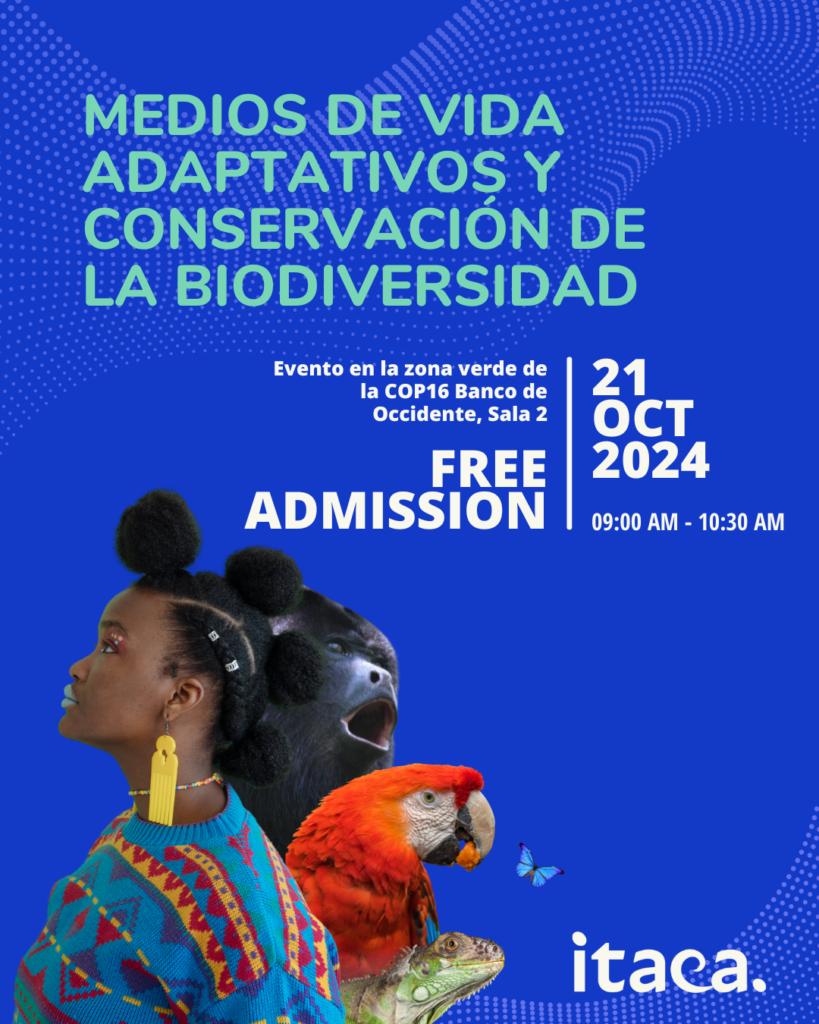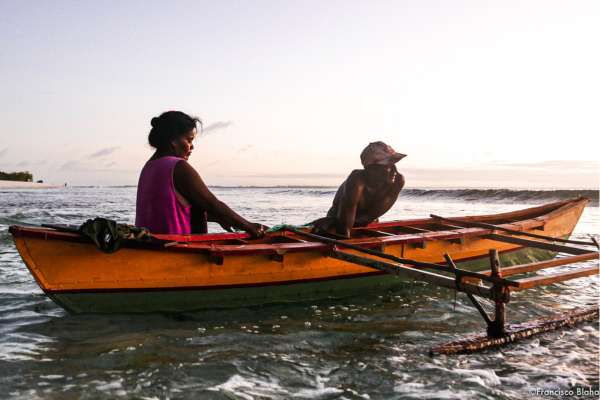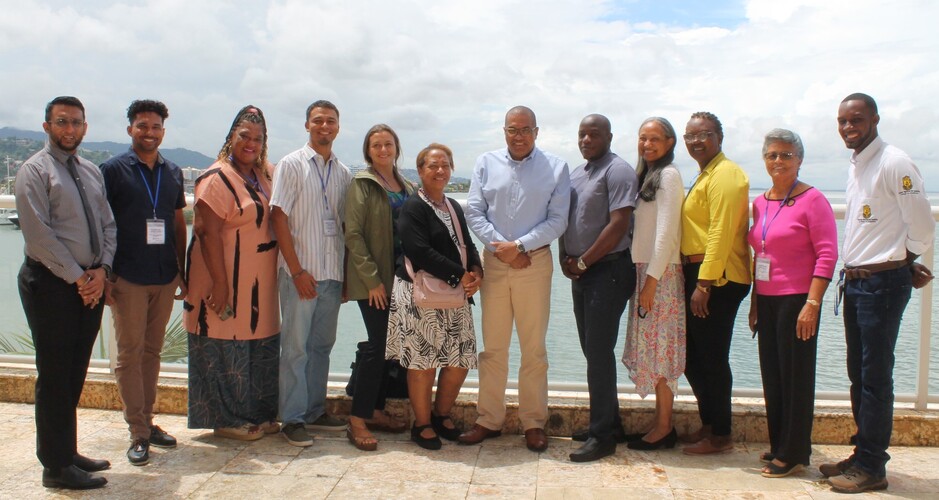Written by:

Dr Laura Canevari
CEO
Adaptive livelihoods and biodiversity conservation are crucial components in building a sustainable future in the face of climate change. As the world grapples with environmental challenges, it is becoming increasingly clear that local communities must be at the heart of solutions. Adaptive livelihoods, when aligned with biodiversity conservation, offer a powerful framework for fostering resilience. By integrating sustainable practices into daily life, communities can enhance both their well-being and the health of ecosystems, ensuring long-term environmental and socio-economic stability.

CONTEXT
The “World Café” session on “Medios de vida adaptativos y conservación de la biodiversidad” at the COP Biodiversity summit in Cali on October 21 gathered experts, practitioners, and community leaders to explore how adaptive livelihoods bridge the gap to biodiversity conservation. Hosted by ITACA Solutions and moderated by Dr. Canevari, the session aimed to identify strategies that empower local communities to create resilient livelihoods aligned with conservation efforts. These discussions are crucial, given the increasing global recognition that local livelihoods and biodiversity goals must go hand-in-hand for long-term sustainability.
WORLD CAFE DYNAMICS
In this interactive World Café session, three leading experts explored the essential pillars linking biodiversity conservation with adaptive livelihoods: Catalina Valenzuela, from Innovus Consulting, discussed the critical role of gender equality in environmental stewardship, highlighting the significant, yet often overlooked, contributions of women in biodiversity conservation. Dr. Monica Altamirano, from Altamira, presented financial innovations that address funding gaps, essential for supporting biodiversity projects and enhancing adaptation to climate change. Nelys Bosquez, from ICEPED, focused on the importance of community involvement as a cornerstone for sustainable resource management, emphasizing the pivotal role of local knowledge and community organization in conservation efforts. Each expert led discussions at their designated tables, where participants rotated through sessions to dive deeper into each pillar, exchanging insights on the challenges and opportunities related to sustainable development and climate adaptation.



KEY REFLECTIONS FROM THE DISCUSSIONS
FINANCE
Dr. Monica Altamirano emphasized the urgent need to transform financial planning to better support biodiversity conservation and adaptive livelihoods. Traditional funding models, often limited by short-term and sector-specific budgets, struggle to provide the long-term support required for regenerative projects. Dr. Altamirano advocated for a paradigm shift towards integrated, long-term investment strategies that regenerate both natural and social capital. She highlighted that a thriving ecosystem is not only an environmental asset but also a critical economic resource.
At the finance discussion table, participants delved into the challenges of securing consistent funding for biodiversity-focused projects. Many recognized the importance of fostering public-private partnerships, aligning private investment with community-driven goals such as sustainable tourism and agroforestry. One participant shared a successful collaboration with academia to access funds for conservation research, while others stressed that understanding private sector needs could open up new avenues for collaboration. The group also emphasized that a shared “language” and a collaborative mindset between investors and community leaders are crucial for translating local needs into viable, bankable projects.
In conclusion, the finance discussion reinforced the need for an adaptable, mission-driven approach to attract diverse funding streams capable of sustaining long-term conservation and adaptive livelihood objectives.
COMMUNITY IN BIODIVERSITY CONSERVATION AND ADAPTATIVE LIVELIHOODS
Dr. Nelys Bosquez highlighted the pivotal role of communities as guardians of biodiversity. She emphasized that communities are not homogeneous, but consist of diverse actors—such as fishers, educators, and local authorities—each with unique relationships to natural resources. Dr. Bosquez stressed that local knowledge, passed down through generations, is an invaluable resource for sustainable resource management. Coastal communities, for instance, possess intricate knowledge of seasonal fish migration and ecological cycles, allowing them to make informed, sustainable harvesting decisions.
Discussions at the community table reinforced the idea that effective conservation efforts must be rooted in community-led initiatives. Participants explored the potential of cooperative practices, such as forming local management councils or community cooperatives, to empower communities in decision-making. Examples included initiatives where educational communities played a key role in conservation, with teachers and students acting as ambassadors for biodiversity in their local environments.
Furthermore, the conversation touched on the evolving impacts of globalization, especially digital platforms that connect local communities with external actors, such as tourists. This shift has opened opportunities for eco-tourism and other non-extractive livelihoods, enabling communities to generate income while preserving their ecosystems. In conclusion, the group agreed that for adaptive livelihoods and conservation efforts to succeed, they must empower communities as active custodians of their environment, not just as beneficiaries.
GENDER AND BIODIVERSITY CONSERVATION
Catalina Valenzuela’s discussion on gender highlighted the indispensable role of women in biodiversity conservation and adaptive livelihoods. She pointed out that women often serve as both caretakers and environmental stewards within their communities, contributing through monitoring activities, sustainable practices, and traditional ecological knowledge. Yet, these roles are frequently undervalued, with women facing systemic barriers to decision-making and resource access. Catalina also argued that inclusive strategies that elevate women’s voices and leadership are essential for achieving resilient communities and sustainable ecosystems.
The gender table’s discussions brought attention to several barriers and opportunities. Participants shared observations on how cultural norms sometimes restrict women’s participation in conservation, particularly in public and leadership roles. One poignant example was shared of female monitors in rural communities who track fish sizes and environmental changes but lack formal recognition or decision-making power. This exclusion not only sidelines crucial knowledge but also limits the potential of conservation efforts to be community-driven and holistic.
To address these challenges, participants proposed initiatives to create more inclusive spaces where women could contribute fully. Ideas included providing logistical support, like childcare, to enable women to attend community meetings, and designing projects with intentional gender inclusivity. For instance, supporting women’s cooperatives in eco-friendly handicrafts or agricultural projects could promote both gender equity and environmental stewardship. Overall, the group acknowledged that empowering women is not just beneficial but vital, as women play an irreplaceable role in the fabric of adaptive, sustainable communities.
CONCLUSION
The World Café session at COP Biodiversity in Cali underscored the importance of a multi-faceted approach to adaptive livelihoods that integrates community agency, innovative finance, and gender inclusion in support of biodiversity outcomes. Through these interconnected pillars, stakeholders can craft strategies that ensure not only the preservation of biodiversity but also the socio-economic resilience of local communities. A recurring theme from the event was that sustainable conservation must be collaborative, inclusive, and adaptable to the unique needs and knowledge of each community.
Moving forward, the commitment to adaptive livelihoods and biodiversity will require continuous support in these critical areas. Building on the discussions, future initiatives should prioritize creating pathways for women’s leadership, strengthening financial frameworks that attract sustainable investments, and deeply embedding community voices in decision-making processes. By embracing this holistic approach, we can foster a future where communities are both protectors of biodiversity and beneficiaries of its abundant resources, ensuring ecological and human resilience in the face of global change.
The organizer and panelist would like to thank all the participants who actively engaged in this discussion: Laura Villarraga, Manuela Castro, Karla Sanabria, Jorge Eduardo Ortiz, Andrea Aguilar, Andrea Martínez, Flórez Melissa Toro Silva, Fernando A.Cuervo y Juan Castellanos. Muchas gracias por compartir sus reflexiones y experiencias y acompañarnos en este evento!
Related posts
sign up our newsletter
ITACA Solutions is a technical services provider focused on implementing climate adaptation in coastal areas in the Caribbean. Sign up to our mailing list to receive our newsletter with updates about our work, publications, activities and events.





